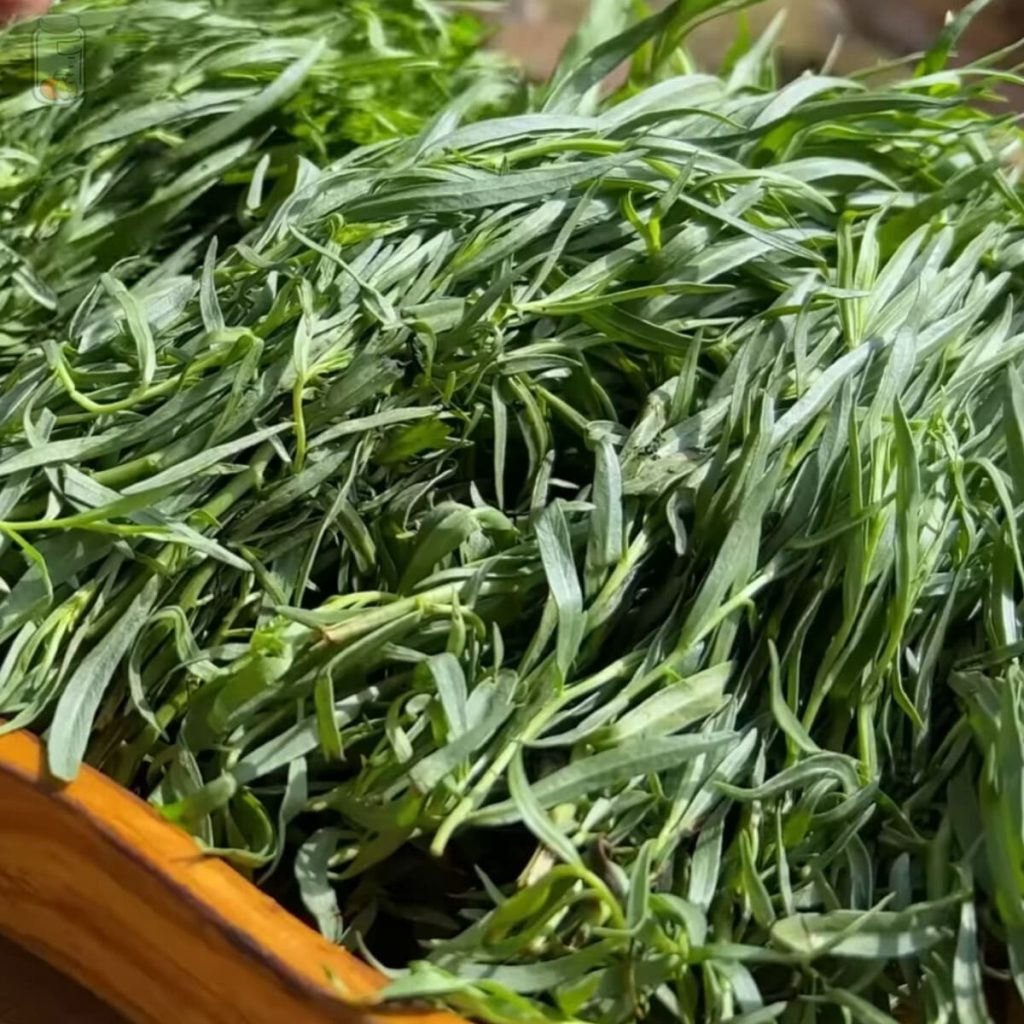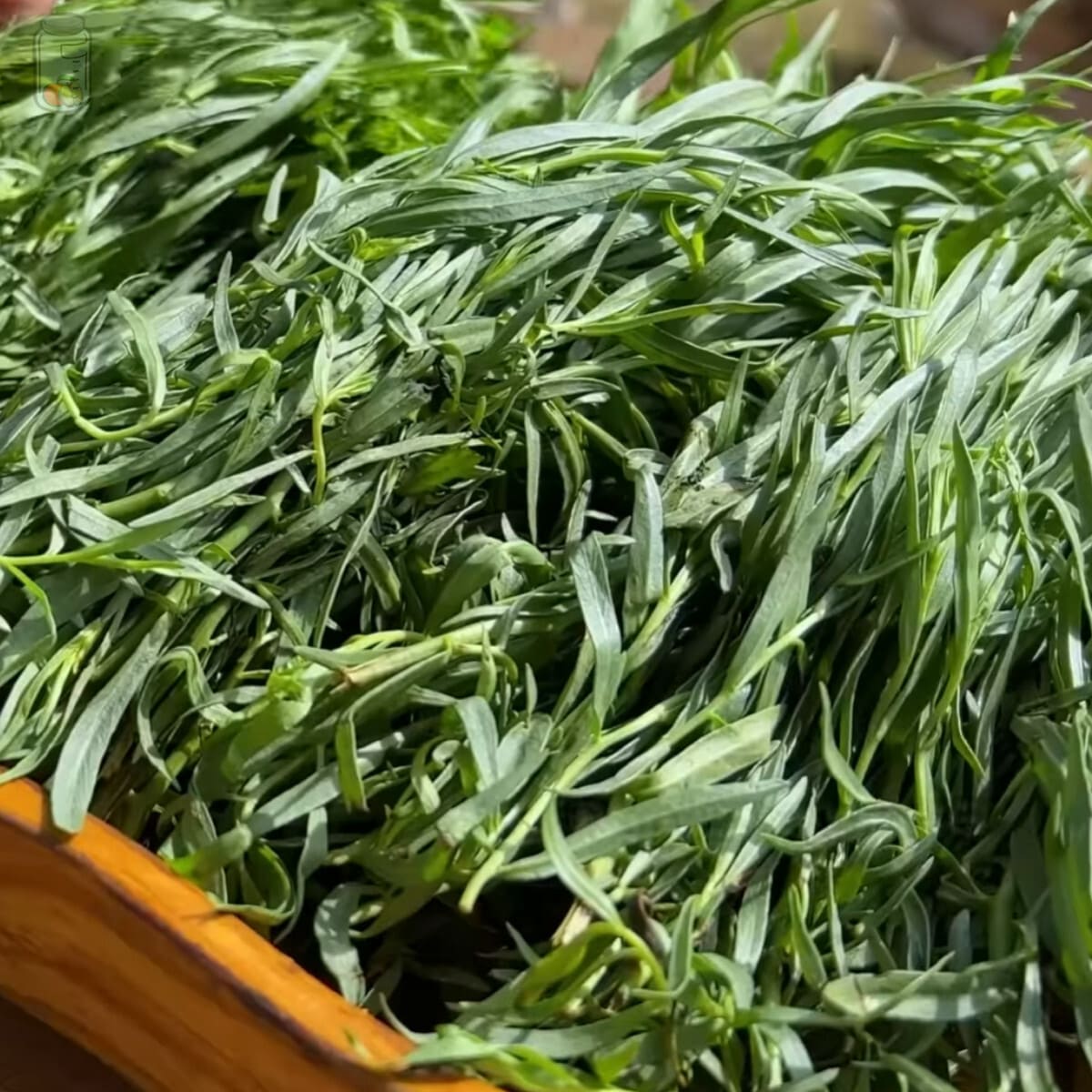Tarragon is an herb used for medicinal or gastronomic purposes, and it is not very popular as cilantro or parsley (click on each of them to see the storage guide). Still, as you may have it in your kitchen, I will teach you how to store tarragon.
You can keep tarragon fresh in the fridge for 7 to 10 days. And if you freeze it for 1 or 2 months. Another alternative would be dehydrating it, which will last a year at room temperature.

To learn how to preserve tarragon correctly, you must continue reading.
Table of Contents
- How to select tarragon
- How to store tarragon in the refrigerator
- How to freeze tarragon
- How to dehydrate tarragon
- How to preserve tarragon in oil
- How do you know if tarragon got bad?
- Why is tarragon spoiled?
- How long does tarragon last?
- What is the best way to preserve tarragon?
How to select tarragon
Knowing how to choose tarragon fresh will help you keep it longer. To do this, select the tarragon with the greenest and most vibrant leaves, and ignore those with yellow, dry, or lifeless leaves.
Nor should you choose watery or moldy tarragon with rotten or pierced leaves.
How to store tarragon in the refrigerator
The first option to store tarragon is in the fridge, and here you can refrigerate fresh tarragon in two ways:
How to keep tarragon fresh in the fridge
- Step 1: Wash away the tarragon.
Wash it with plenty of water, and then, if you have a salad spinner, use it to dry the tarragon. If you don’t have one, shake off the tarragon and dry it with absorbent paper.
- Step 2: Wrap the tarragon.
Gather several tarragons, but not too many, and wrap them with a slightly moistened paper towel. Next, add another layer of paper towels, but it should be dry this time.
- Step 3: Put the tarragon wrapped in a bag.
Place the tarragon wrapped inside a plastic bag. When closing it, try not to be so tight. You can also wrap the tarragon branches in a plastic container with a lid (not airtight).
- Step 4: Set the storage date.
Write down the date of storage of the tarragon.
- Step 5: Store the fresh tarragon in the fridge.
You must place it in the coldest part (bottom). The fresh tarragon will remain refrigerated for 7 to 10 days. [1]
How to preserve tarragon in water
Here you will keep the tarragon branches as you do with the bouquets. Follow the steps I left you below:
- Step 1: Wash away the tarragon.
With this, we seek to remove anything that accelerates the decomposition of the leaves of tarragon. So, with plenty of water, remove all the dirt well.
The ideal would be to dry it with a salad spinner, but if you do not have one, shake the branches well before drying them with paper towels.
- Step 2: Prepare the container with the tarragon.
You need a glass or container to act as a vase. Then gather several branches of tarragon in the container; the idea is to put the part of the stem without leaves (root) in the water. Next, you can remove some leaves from the bottom.
Cover half the stem with water, but ensure no leaves touch the water. Finally, cover this bouquet with a plastic bag.
- Step 3: Write down the storage date.
Attach a label with the date of storage of the tarragon on the container or bag.
- Step 4: Store the fresh tarragon in the refrigerator.
Place the vase in the coldest area of your refrigerator, so the tarragon in water will stay fresh for 7 to 10 days, but you will have to change the water every three days.
How to freeze tarragon
Can tarragon be frozen? Yes, you can freeze tarragon. Although it will not be as fresh, it will keep its taste and smell a little.
- Step 1: Wash away the tarragon.
The branches go with enough water. Remove the root if you still keep it and eliminate the yellow leaves. Drain well and dry with paper towels or a salad spinner.
- Step 2: Blanch the tarragon.
Take a pot of water to the stove, add the tarragon branches when it boils, and let it cook for 45 seconds. Then, take the tarragon out of the water and pour it into a bowl with cold water and ice to stop the cooking. Leave it there for a minute.
- Step 3: Dry the tarragon.
Drain the tarragon and dry it well with paper towels.
- Step 4: Bag the tarragon.
Wrap several branches with plastic film, and then you can put it inside an airtight bag or container apt to be in the freezer.
- Step 5: Write down the freezing date.
Write on the bag the date of storage of the tarragon. Or put that information on a label that you’ll then stick to the container.
- Step 6: Store tarragon in the freezer.
You may freeze tarragon for 1 or 2 months. [2]
You can also freeze tarragon without blanching, but it will likely lose a lot of its smell and taste. You can follow the same steps I gave you but ignore the second step.
How to dehydrate tarragon
If you want to keep tarragon for a long time, you can dehydrate it, but I warn you that its flavor will be a little reduced, but you compensate by using more.
You can dehydrate tarragon in three ways:
Dehydrate tarragon outdoors.
This method is the one that requires much more time.
- Wash the tarragon branches.
- Drain them and dry them well.
- Join a few branches with a rope or band.
- Hang the tarragon upside down in a dark and ventilated place. Not much dust should accumulate in that place.
Tarragon should be dehydrated in a week or two. You will know it is ready if it falls apart when you squeeze a leaf.
Dehydrate tarragon with a food dehydrator.
- Wash the tarragon.
- Dry it.
- Put the branches inside the dehydrator trays without piling them up or putting them together so that the air circulates better.
- Set the temperature to about 40°C or 50°C (105°F – 120°F) and dehydrate for 2 or 4 hours until the leaves break to the touch.
Dehydrate tarragon with an oven.
- Wash the tarragon branches.
- Drain them and dry them well.
- Prepare a tray with a nonstick sheet or parchment paper.
- On top, place the tarragon branches.
- Preheat the oven to the lowest possible temperature for a few minutes.
- Put the tray in and dehydrate for 1 or 2 hours. When tarragon leaves fall apart when touched, they are ready.
Put it inside a glass jar with an airtight lid to store dry tarragon.
You can store the dehydrated tarragon in a dry, cool, and dark place (the pantry) for a whole year.
Or keep the dried tarragon inside the freezer; just change the container to a bag suitable for freezing, and there it will remain for 18 to 24 months. Remember to write the storage date of the dry tarragon.
How to preserve tarragon in oil
There are two ways to preserve tarragon in oil, depending on if you store it in the fridge or the freezer.
Store tarragon in oil in the fridge
- Step 1: Wash away the tarragon.
The branches go with enough water. Remove the root if you still keep it and eliminate the yellow leaves. Drain well and dry with paper towels or a salad spinner.
- Step 2: Place the tarragon in a glass jar.
Place the tarragon inside a glass jar with an airtight or screw lid.
- Step 3: Fill with oil.
Fill it in olive or vegetable oil. Then, to make the oil better absorb the taste of tarragon, crush it a little with the stick of a wooden bucket.
- Step 4: Cover the jar.
Cover the container tightly and write the storage date.
- Step 5: Store in the fridge.
Place the jar with tarragon in oil in the refrigerator for an entire month. After that time, you must remove the branches, but the oil will be impregnated with tarragon.
Store tarragon in oil in the freezer
The second way to preserve tarragon in oil is to freeze it as follows:
- Step 1: Wash the tarragon and remove its leaves.
Beat the tarragon with enough water, drain paper towels, or use a spinner salad. Then, remove all the tarragon leaves and remove the stem.
- Step 2: Fit into the molds to make ice cubes.
Grab a handful of tarragon leaves and tuck them inside the mold compartments to make ice cubes. Then, cover it with olive or vegetable oil.
- Step 3: Freeze the tarragon for 2 hours.
Put the molds inside the freezer and wait for them to freeze completely.
- Step 4: Unmold and bag.
When the oil and tarragon cubes are frozen, please remove them and put them inside an airtight freezer bag.
- Step 5: Label the container.
Put the date of storage of the tarragon on the bag.
- Step 6: Store the tarragon and oil cubes in the freezer.
In this way, you can freeze tarragon in oil for six months. You don’t need to thaw them, as you can add them directly to recipes this way.
How do you know if tarragon got bad?
Tarragon is spoiled when it withers or when its leaves become viscous, in that case, thrown or thrown away.
If the tarragon emits a bad smell, such as stinky, it is in bad condition. Or when it develops mold, that is, black or white spots or lint appear on its leaves or stem. Since it is no longer safe to eat it in these cases, you will have to discard it.
Why is tarragon spoiled?
Tarragon is an herb, and like all grass, it is delicate. After harvesting, it begins its natural decomposition process, and its leaves will start to soften and wither.
Besides, as they are not in contact with the earth, tarragon cannot be nourished, so its leaves will go their color and freshness.
The heat and humidity encourage the development of harmful microorganisms, which will shorten the life of tarragon. Therefore, it is essential to store them properly to prevent them from becoming contaminated.
How long does tarragon last?
| Product | Duration |
| Fresh tarragon in the fridge | 7 to 10 days |
| Frozen tarragon | 1 – 2 months |
| Dehydrated tarragon at room temperature | 1 year |
| Dehydrated tarragon in the freezer | 18 – 24 months |
| Tarragon in oil in the fridge | 1 month |
| Tarragon in oil in the freezer | 6 months |
What is the best way to preserve tarragon?
The best way to keep tarragon fresh is inside the fridge, in a container with water, or wrapped in paper towels since freezing loses flavor unless you blanch it.
However, you can freeze tarragon in oil; that way, it will keep its flavor much more and for a little longer.
By keeping tarragon in vinegar, you can store it at room temperature, but in this case, it is better to keep it in the fridge,
To preserve tarragon for much longer, dehydrate it, although you will somewhat reduce its flavor.
Check the following posts if you want to learn how to preserve some other herbs or any other food.
[1] https://lee.ces.ncsu.edu/wp-content/uploads/2012/12/TheFoodKeeper.pdf?fwd=no
[2] https://foodbanksbc.org/wp-content/uploads/2014/12/Food-Storage-Guidelines3.pdf







